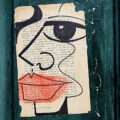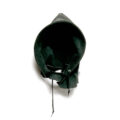Conversations: Molly Gaudry and Kristina Marie Darling
 Molly Gaudry (L) and Kristina Marie Darling (R)
Molly Gaudry (L) and Kristina Marie Darling (R)
Molly Gaudry was shortlisted for the 2011 PEN/Joyce Osterweil for her first verse novel, We Take Me Apart, which was also finalist for the Asian American Literary Prize for Poetry. Richard Garcia wrote of her debut, “The ordinary becomes mythical…and simple lines or sentences ring with ominous music,” and Brian Evenson writes, “Gaudry’s Beckettian narrative sews bright bits to near-faint whispers, slowly swaddling us in quiet and darkness.” Its companion novel, Desire: A Haunting, will be released in December 2015 from Ampersand Books. Gaudry is a faculty member at the Yale Writers’ Conference and the Creative Director at The Lit Pub.
Kristina Marie Darling is the author of over twenty collections of poetry and hybrid prose. A poet, fiction writer, and critic whose writing has been called “singularly graceful and stunningly incisive explorations of poetic insight” (Zach Savich), her work has been reviewed in numerous literary magazines including The Iowa Review, Ploughshares, and Boston Review. Darling holds an MA in Philosophy and is currently a Presidential Fellow and Gender Institute Dissertation Fellow at SUNY-Buffalo for a PhD in English Literature.
Darling and Gaudry corresponded over the summer of 2015, discussing their current and forthcoming work, violence and literature, how an author’s identity can haunt their writing, collaboration with visual artists, and more.
Kristina Marie Darling: Desire: A Haunting is formally adventurous, offering readers white space, lyric fragments, and beautiful fractures. Tell me about your process. How did that spare, very poetic form emerge? Were form and narrative linked from the beginning?
Molly Gaudry: It took me over a year and a half, after the story was written, to find the form for Desire. Initially, it mimicked my first book, We Take Me Apart, in which the narrator’s lines break syntactically. Her daughter, the narrator of Desire, sounds like her in this way, but her lines don’t break on breaths—they break on long stretches of silence. And these silences, visible, draw attention to absence and ghostliness; they perform on my narrator’s behalf the sadness of not just herself but also her voice being erased from memory.
So now I’ll flip the question around and ask you about your process and what generated the idea for Women and Ghosts.
KMD: When I first started drafting Women and Ghosts, I was thinking a lot about the idea of textual violence and more specifically, the extent to which reading from a place of privilege can become an act of violence. As a young female writer, I can say this type of violence has certainly happened to some of my poems. An older male writer, much more established than myself, once blacked out my manuscript, wrote sexually explicit things on the work, and sent it to me in the mail. While this individual clearly doesn’t represent all older, established male writers, I do view this as instance of textual violence, especially because an imbalance of power was at play.
When drafting the memoir, I wanted to explore the ways that violence (textual and otherwise) can give rise to self-destructive impulses. In other words, how does erasure of one’s labor, one’s voice, and one’s intentions give rise to self-erasure? Can self-awareness and awareness of this cultural machinery help one reclaim one’s voice? I hope these concerns come through in the formal choices I’ve made. The book makes use of self-erasure and footnotes, as well as grayscale and erasures of Shakespeare’s tragedies (particularly Hamlet). I’m intrigued by the idea that form and the visual appearance of a poem, essay, or story can be politically charged, perhaps just as meaningful as the text itself.
I’m also deeply invested in the idea of erasure as excavation, an effort to redirect the reader’s focus and prompt them to attend to something they wouldn’t ordinarily notice. I trust that the erasures prompt the reader to confront gendered violence and the erasure of women’s voices, as violence and erasure occur in some of the most canonical texts. To consider the myriad ways that literature shapes the cultural imagination. To spark a larger conversation about ethical reading practices.
MG: Did Jen Bervin’s Nets have any influence on Women and Ghosts? Or if not, what authors and books did?
KMD: I think my process was actually a lot like yours: that the story for Desire was finished, but you continued to search for a form, a vehicle for the story that would do justice to your ideas. I finished much of the text for Women and Ghosts, but it felt disconnected, as though it were merely a collection of separate essays. While at a residency in Wyoming, I showed my work to the wonderfully talented Phil Zimmerman, a book artist, who suggested that I use the visual presentation of the work, and various typographical treatments, to unify the disparate ideas in the collection. After my discussion with Phil, I had a breakthrough, and was able to revise the draft so that it felt more cohesive, more unified.
As I revised, I looked at many examples of texts that use the space of the page as a visual field. You’re absolutely right that Jen Bervin was hugely influential for me. Her work prompted me to consider the ways a text, and more specifically, an erasure, is haunted by its source materials. Every text is haunted by a deeply problematic and ethically fraught literary inheritance. Even more importantly, Bervin prompted me to think about what it means to haunt a text myself. As a woman inhabiting a predominately male literary cannon, am I uninvited guest, rustling through a dim corridor in my white dress? What does it mean to haunt one’s own texts? Can different parts of the self or parts of consciousness exist in dialogue with each other in the same rhetorical space? As I considered these questions and many others, I also looked at Ronald Johnson’s Radi Os, Janet Holmes’ The Ms of My Kin, and of course, Yedda Morrison’s Darkness, all of which use the space of the page differently, allowing white space to signify absence and presence, violence and respite.
I’d love to hear more about the visually arresting presentation of your work in Desire. To what extent is writing always visual in nature, even when we don’t fully recognize it?
MG: I really love your question: “What does it mean to haunt one’s own texts?” This summer, suddenly and unexpectedly, I finished a close-to-final draft of the third book in the series, Fit Into Me, a lyric memoir about reading, writing, love, and sex. It wasn’t until I had a clearer understanding of the larger scale concerns of Fit that I realized just how much of myself I had put into Desire. Dog’s willful denial of the violence in her past is my own. Her silence—I think she keeps it for me. Her own broken vocal cords and William’s cut neck, the broken-necked flowers in We Take Me Apart that dog’s mother sews back together after a storm—these aren’t just gory details. Writing Fit, I came to better understand why I was so insistent on the achronology of Desire, why I fought so hard to have Parts One and Two follow chronologically but Part Three exist entirely in flashback. Desire ends in memory, picks up where We Take Me Apart leaves off. Desire ends in the unspeakable past. I guess it makes more sense to me, even now, why it took so long for me to find the right form for Desire. All that unvoiced pain, visible on the page and breaking, breaking, breaking.
What about your decision in Women and Ghosts to use grayscale as well as strike-through to create the erasures? Is it a double erasure? Or a move that makes the invisible actually more visible?
KMD: In some ways, my answer echoes your beautiful description of a text in which secrets are buried, one after the other, creating a topography of the unspeakable.
When I started writing Women and Ghosts, I struggled with how to write about something that I considered completely, undoubtedly, and perhaps always unspeakable. I won’t go into laborious detail, but several years ago, I was nearly (and I stress the word nearly) victimized in a rather horrific way by a man whom I trusted and, at the time, believed that I loved. For years, I had tremendous difficulty possessing a sense of self that bore any resemblance to victimhood. It felt like someone else’s sorrow, as if someone stood behind me, buttoning a dress I didn’t want to be seen in. Not then, not ever. Maybe this is why I failed five times over at writing the book, and kept starting again.
The grayscale represented a tremendous breakthrough in my thinking about narrative and narrators. The grayscale and strike-through allowed for a dialogue between parts of the self and parts of consciousness, some of them fictional, some of them more real or more true than others. That way, I didn’t have to own any one self or any one relationship to that trauma. Rather, it could be presented in a way that’s as multifaceted, complex, and contradictory as such things often are.
I think we both share an interest in using fictional personae to represent experience in a way that seems emotionally true, perhaps even more so than a straightforward memoir ever could. What do you think about the relationship between autobiography, hybrid texts, and the unconscious? How much of this process can be carefully planned? Do you recognize parallels to your own life and its ghosts after the manuscript is complete?
MG: The generative constraint I use addresses these questions in a roundabout way. I make word lists from other texts, and I attempt to connect them into narratives. Gertrude Stein’s Tender Buttons was the source text for We Take Me Apart. John Ratti’s A Remembered Darkness, for Desire. And Anne Carson’s translation of Sappho’s fragments, If not, winter, for Fit Into Me. I don’t do well with a blank page and need help getting started.
This constraint taps into the unconscious, which yields stronger, more complex voices than I could craft deliberately. The joy is in discovering those parallels to my own story, after the words are down—for instance, how does the ghost of Pearl Prynne have anything to do with me? Sometimes these discoveries are welcome and other times unexpected and terrifying in what they reveal, particularly because I am a fragment of my narrators’ autobiographical “I’s” and they are fragments of my own beneath-the-surface, unconscious “I.”
So what’s next for you? What are you working on now?
KMD: I’m currently hard at work on two projects, which are very different from Women and Ghosts. Yet somehow, every text that I inhabit turns into a haunted house. With that in mind, let me tell you about The Ghosts of Birds. I met a very talented visual artist, Kristin Giordano at a residency on the Long Beach Peninsula in beautiful coastal Washington. At the time, Kristin was photographing and documenting a mass die-off of very tiny birds all along the coast. She took striking black and white photos, which I’m writing a sequence of poems in response to. They’re the very first poems I’ve written in a long time that use line breaks, and their subsequent moments of silence and respite, so I’m excited that the collaboration has prompted me to step out of my comfort zone.
I’ve also been collaborating with poet John Gallaher, whose work I’ve admired for quite a while. We take turns writing prose pieces, which started out as landscape poems, but it didn’t very take long for ghosts to start appearing in the manuscript. With that in mind, the project is called “GHOST / LANDSCAPE.” Some excerpts have appeared or are forthcoming in The Journal, Diode, OmniVerse, Requited, and elsewhere.
And I’d love to hear more about your current projects, Molly. What can readers look forward to?
MG: Both of your projects sound amazing. I’m impressed, too, by your ability to collaborate with others (generally speaking, I’m not). At the moment, I’m not really working on anything new.
It’s my reading year here in Utah, and my exam—on the 120 books on my list from Homer to Rankine—is my primary concern. That said, here are some of my current personal reading/researching obsessions: Keats’s “Lamia” and “Isabella and the Pot of Basil”; Mary Shelley’s Frankenstein; Jason Colavito’s Knowing Fear: Science, Knowledge and the Development of Horror; Angela Carter’s “The Bloody Chamber” and Maria Tatar’s Secrets beyond the Door: The Story of Bluebeard and His Wives; Leigh Gilmore’s The Limits of Autobiography: Trauma and Testimony; and the medieval figure St. Olga of Kiev.
Surely, these texts—and more, as yet unread—will become something, but for now I must get back to reading for my exams.





